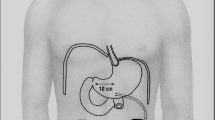Abstract
Background
Studies have shown high-frequency, low-energy gastric electrical stimulation (GES) to be an effective management strategy for patients with medication refractory gastroparesis. However, placement of a permanent GES device requires surgery and has considerable cost considerations. More importantly, however, this mode of therapy may not be successful for all patients. Patients likely to benefit from such an invasive and expensive procedure could be selected on the basis of their response to temporary GES. Electrodes for the purpose of temporary GES usually are placed percutaneously or through a percutaneous endoscopic gastrostomy (PEG) tube (PEGStim). This study demonstrated an easier and less cumbersome placement of these electrodes endoscopically [1-3].
Methods
The current case involved a 32-year-old man with diabetic gastroparesis. The endoscopic methods and protocol were approved by the Institutional Review Board at the University of Mississippi, Jackson, Mississippi. Informed consent was obtained before the procedure. Standard upper endoscopy was performed initially. A temporary cardiac pacing lead (Model 6414-200; Medtronic, Minneapolis, MN, USA) was used as the electrode. The video demonstrates an innovative technique of endoscopic placement of electrodes for temporary GES. The external stimulation device used was the standard GES device (Enterra; Medtronic).
Results
Temporary GES produced a rapid and marked improvement in the patient’s intractable symptoms, improvement in his health-related quality-of-life score, electrogastrography parameters, and gastric emptying. Although the temporary electrodes could have been removed easily by gentle traction in a counterclockwise direction, the patient desired that the electrodes be left in place until permanent electrode placement.
Conclusion
For patients such as the man in the current case, who do not have a preexisting PEG tube, the authors demonstrated that endoscopic placement of electrodes is technically feasible. The reported patient likely will benefit from surgical placement of a permanent GES device. Thus, the authors propose ENDOStim as the preferred method for placement of electrodes for temporary GES.
Similar content being viewed by others
References
Abell TL, Bernstein RK, Cutts T, Farrugia G, Forster J, Hasler WL, McCallum RW, Olden KW, Parkman HP, Parrish CR, Pasricha PJ, Prather CM, Soffer EE, Twillman R, Vinik AI (2006) Treatment of gastroparesis: a multidisciplinary clinical review. Neurogastroenterol Motil 18:263–283
Jones MP, Maganti K (2003) A systematic review of surgical therapy for gastroparesis. Am J Gastroenterol 98:2122–2129
Ayinala S, Batista O, Goyal A, Al-Juburi A, Abidi N, Familoni B, Abell T (2005) Temporary gastric electrical stimulation with orally or PEG-placed electrodes in patients with drug refractory gastroparesis. Gastrointest Endosc 61:455–461
Disclosures
Thomas L. Abell is a licensor, investigator, speaker, and consultant for Medtronic Inc. Shou-Jiang Tang is a consultant for Olympus America Inc. Sumanth R. Daram has no conflicts of interest or financial ties to disclose.
Author information
Authors and Affiliations
Corresponding author
Electronic supplementary material
Below is the link to the electronic supplementary material.
Supplementary material 1 (MPG 237291 kb)
Rights and permissions
About this article
Cite this article
Daram, S.R., Tang, SJ. & Abell, T.L. Temporary gastric electrical stimulation for gastroparesis: endoscopic placement of electrodes (ENDOstim). Surg Endosc 25, 3444–3445 (2011). https://doi.org/10.1007/s00464-011-1710-5
Received:
Accepted:
Published:
Issue Date:
DOI: https://doi.org/10.1007/s00464-011-1710-5



